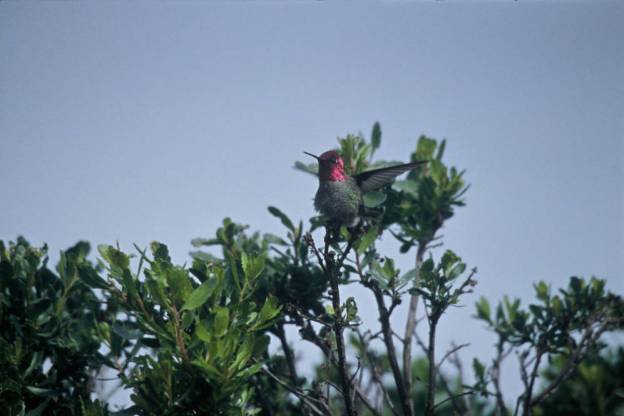The hummingbird that had been at the home of Howard and Faye Guinn since October departed on Dec. 23. Faye informed me of the bird’s departure in an email.
“I got to have a winter hummingbird for two days of winter,” she wrote. “He surely decided to spend the holidays in Mexico. I hope he finds flowers in bloom there. Hummingbirds and flowers just go together.”
••••••
I had written about wintering hummingbirds in previous blog posts, including the one visiting the Guinn home near Jonesborough, Tennessee. After reading one of my recent blog posts on wintering hummingbirds, I received an email from Oscar, a resident of Vancouver, Canada, and a self-proclaimed “bird-lover.”
He also informed me that wintering hummingbirds are not a phenomenon exclusive to the United States. Some of these tiny birds also spend time north of the border during the winter months.
“We are delighted to have these beautiful little birds visiting our feeder at our window every day,” Oscar wrote. “Every 10 minutes he drinks and goes back to the same tree branch.”
While Vancouver is a rather temperate city, Oscar said the temperature can get cool on some days.
“He doesn’t go away for long periods,” Oscar reported. “It seems to look like he is afraid to lose his food to another bird, when his partner tries to feed he chases him away like he is very upset and not sharing his food, no matter what. Is this behavior common among these birds?”
In my reply, I did note that hummingbirds are usually quite territorial. Any readers who hosts more than one hummingbird at a time is probably familiar with the chasing antics Oscar described in his email.
“Watching this is so entertaining , like a gift from God,” Oscar shared. “We can’t have enough of it.”
I did some research, which informed me that Oscar’s visiting hummingbirds are likely Anna’s hummingbirds.
A species native to western North America, the Anna’s
hummingbird is a year-round resident of the Pacific Coast. It ranges from northern Baja to points as far north as Vancouver and southern British Columbia.

Photo by U.S. Fish and Wildlife Service A male Anna’s Hummingbird spreads it wings while settling onto a perch.
René Primevère Lesson, a French ornithologist and author of a manual for ornithology, gave the Anna’s Hummingbird its name.
This bird was named after Anna Masséna, Duchess of Rivoli. She served as an attendant for Empress Eugenie, the wife of Napoleon III and the last Empress consort of the French.
Another hummingbird — the Magnificent Hummingbird — was also named by Lesson to honor François Victor Masséna, the Duke of Rivoli and husband of the Duchess Anna. Until the 1980s this large hummingbird was known as Rivoli’s Hummingbird.
In the early 20th century, Anna’s hummingbird bred only in northern Baja California and southern California. Modern landscaping techniques, including the planting of exotic shrubs and flowers, has helped this hummingbird expand its range north, especially in urban and suburban areas.
I’ve seen several of the western species of hummingbirds, but I haven’t had the opportunity to observe an Anna’s Hummingbird. I suppose that species remains near the top of my “bird bucket list.”
•••••••
Until the recent cold snap, it has been a relatively mild winter. Even the Arctic blast produced mostly cold and very little in the way of snow.
The frigid conditions did, not surprisingly, result in increased traffic at my feeders.
I haven’t hosted any birds as exotic as an Anna’s Hummingbird this winter, but the flocks of Pine Siskins and Purple Finches continue to grow. The arrival of January has seen as many as 25 Pine Siskins and about a dozen Purple Finches at my feeders.
I always offer suet cakes as well as seeds, an offering that seems much appreciated by birds as diverse as Carolina Chickadees and Downy Woodpeckers to Carolina Wrens and Blue Jays. I usually buy commercially prepared suet/peanut butter cakes, which disappear quickly once the birds find them. The occasional squirrel also helps with making short work of them.

Photo by Bryan Stevens A mixed flock of American Goldfinches and Pine Siskins scour the ground beneath a feeder.





